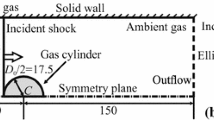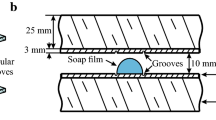Abstract
The problem of shock interaction with a rigid circular cylinder has been investigated using a compressible immersed boundary method coupled with high-order weighted-essentially non-oscillatory (WENO) scheme. First, the accuracy of the developed code is validated. Then, influences of the incident shock Mach number on the flow-field structure and dynamic drag coefficient, as well as time evolution of the flow field are studied. For different shock Mach number, the flow structure shows very different features. At a given dimensionless time, both the normalized shock detachment distance and the normalized vertical distance from the highest point of the primary reflected shock to the centerline of the cylinder decreases with increasing shock Mach number. However, location of the upper triple point varies non-monotonically with shock Mach number. For a case with given shock Mach number, the trajectory of the upper triple point and the time evolution of the normalized vertical distance from the highest point of the primary reflected shock to the centerline of the cylinder can both be predicted by linear correlation. Nevertheless, the time evolution of the normalized shock detachment distance is biased to be non-linear. Meanwhile, time evolution of force exerted on the cylinder is quite unsteady for a case with given shock Mach number and given cylinder diameter. For small shock Mach number, there exists a negative valley, and it disappears when the incident shock Mach number increases to a large value, e.g., 1.7. Furthermore, correlations to predict the occurrence of the peak drag and its value under different shock Mach numbers have been proposed.
Similar content being viewed by others
References
Melcher J C, Krier H, Burton R L. Burning aluminum particles inside a laboratory-scale solid rocket motor. J Propul Power, 2002, 18: 631–640
Ling Y, Haselbacher A, Balachandar S. Importance of unsteady contributions to force and heating for particles in compressible flows. Int J Multiphase Flow, 2011, 37: 1026–1044
Ling Y, Haselbacher A, Balachandar S. Importance of unsteady contributions to force and heating for particles in compressible flows, Part 2: Application to particle dispersal by blast waves. Int J Multiphase Flow, 2011, 37: 1013–1025
Parmar M, Haselbacher A, Balachandar S. Improved drag correlation for spheres and application to shock-tube experiments. AIAA J, 2010, 48: 1273–1276
Whitham G B. A new approach to problems of shock dynamics Part I: Two-dimensional problems. J Fluid Mech, 1957, 2: 145–171
Bryson A E, Gross R W F. Diffraction of strong shocks by cones, cylinders, and spheres. J Fluid Mech, 1961, 10: 1–16
Heilig W H. Diffraction of a shock wave by a cylinder. Phys Fluids, 1969, 12: 1–154
Kaca J. An interferometric investigation of the diffraction of a planar shock wave over a semicircular cylinder. UTIAS Technical Note: Institute for Aerospace Studies, University of Toronto, 1988
Takayama K, Itoh K. Unsteady drag over cylinders and aerofoils in transonic shock tube flows. In: Proceedings of the the Fifteenth International Symposium on Shock Waves and Shock Tubes, Berkeley, California, July 28-August 2. Stanford: Stanford University Press, 1985
Tanno H, Itoh K, Saito T, et al. Interaction of a shock with a sphere suspended in a vertical shock tube. Shock Waves, 2003, 13: 191–200
Skews B W, Bredin M S, Efune M. Drag measurement in unsteady compressible flow, Part 2: Shock wave loading of spheres and cones. R & D J South Afri Inst Mech Eng, 2007, 23: 13–19
Yang J Y, Liu Y, Lomax H. Computation of shock wave reflection by circular cylinders. AIAA J, 1987, 25: 683–689
Drikakis D, Ofengeim D, Timofeev E, et al. Computation of non-stationary shock-wave/cylinder interaction using adaptive-grid methods. J Fluids Struct, 1997, 11: 665–692
Zóltak J, Drikakis D. Hybrid upwind methods for the simulation of unsteady shock-wave diffraction over a cylinder. Comp Methods Appl Mech Eng, 1998, 162: 165–185
Bagabir A, Drikakis D. Numerical experiments using high-resolution schemes for unsteady, inviscid, compressible flows. Comp Methods Appl Mech Eng, 2004, 193: 4675–4705
Ripley R C, Lien F S, Yovanovich M M. Numerical simulation of shock diffraction on unstructured meshes. Comp Fluids, 2006, 35: 1420–1431
Parmar M, Andreas H, Balachandar S. Prediction and modeling of shock-particle interaction. In: 47th AIAA AeroSpace Sciences Meeting Including, the New Horizons Forum and Aerospace Exposition. Orlando, 2009. 2009–1124
Sun M, Saito T, Takayama K, et al. Unsteady drag on a sphere by shock wave loading. Shock Waves, 2005, 14: 3–9
Peskin C S. Flow patterns around heart valves: A numerical method. J Comp Phys, 1972, 10: 252–271
Mittal R, Iaccarino G. Immersed boundary methods. Annu Rev Fluid Mech, 2005, 37: 239–261
Scott M, Michael A, Marsha B. Implicit approaches for moving boundaries in a 3-d cartesian method. In: 41st Aerospace Sciences Meeting and Exhibit. Reno, 2003. 2003–1119
Robert E H, Brandon W. Ventus: An overset adaptive cartesian simulation framework for moving boundary problems. In: 21st AIAA Computational Fluid Dynamics Conference. San Diego, 2013. 2009–1124
Jiang X, Chen Z, Li H. Numerical investigation on the interaction of cylinder and shockwave based on the immersed boundary method. Mod Phys Lett B, 2009, 23: 317–320
Ji H, Lien F S, Yee E. Numerical simulation of detonation using an adaptive Cartesian cut-cell method combined with a cell-merging technique. Comp Fluids, 2010, 39: 1041–1057
Chaudhuri A, Hadjadj A, Chinnayya A. On the use of immersed boundary methods for shock/obstacle interactions. J Comp Phys, 2011, 230: 1731–1748
Glazer E, Sadot O, Hadjadj A, et al. Velocity scaling of a shock wave reflected off a circular cylinder. Phys Rev E, 2011, 83: 066317
Yoo C S, Im H G. Characteristic boundary conditions for simulations of compressible reacting flows with multi-dimensional, viscous and reaction effects. Combust Theory Model, 2007, 11: 259–286
Tsai I N, Huang J C, Tsai S S, et al. Unsteady relativistic shock-wave diffraction by cylinders and spheres. Phys Rev E, 2012, 85: 026317
Jiang G S, Shu C W. Efficient implementation of weighted ENO schemes. J Comp Phys, 1996, 126: 202–228
Shu C W, Osher S. Efficient implementation of essentially non-oscillatory shock-capturing schemes. J Comp Phys, 1988, 77: 439–471
Author information
Authors and Affiliations
Corresponding author
Rights and permissions
About this article
Cite this article
Luo, K., Luo, Y., Jin, T. et al. Numerical analysis on shock-cylinder interaction using immersed boundary method. Sci. China Technol. Sci. 60, 1423–1432 (2017). https://doi.org/10.1007/s11431-016-9037-2
Received:
Accepted:
Published:
Issue Date:
DOI: https://doi.org/10.1007/s11431-016-9037-2




